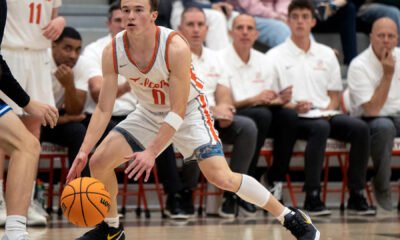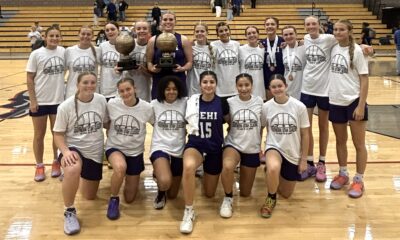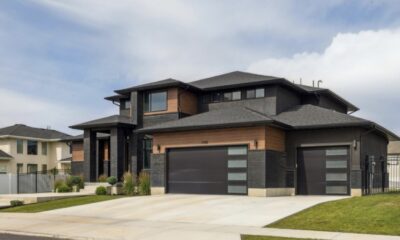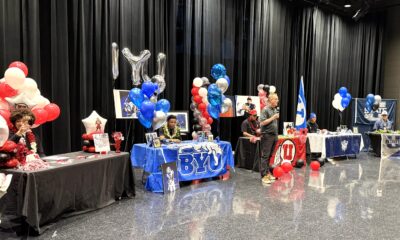Lehi City News
Get to know Mayor-Elect Paul Binns
Published
3 weeks agoon

This week, Lehi Free Press publisher Sally Francom had a wide-ranging conversation with Mayor-elect Paul Binns. We discussed his background, family, professional life, and the critical issues he sees facing Lehi in the coming years.
Sally Francom (LFP): When did you decide to run for mayor?
Paul Binns: I started attending city council meetings back in 2021
LFP: What prompted you to do that?
Binns: Well, there was a high-density overlay that they were going to put in next to our neighborhood. So, we got involved with that. Strata had just come in and occupied that piece of land right up 11th West, and Maverick went in on the corner. I went to that city council meeting when the storage units went in, and I started getting familiar with Lehi City at that point in time. And that [development] is all in my backyard. That’s part of the community I live in.
LFP: Were you concerned about those commercial developments? Or were you just interested?
Binns: I was concerned because on our side (1700 West), we have half-acre parcels. And then, right in between it, on Pioneer Crossing (which was really busy already), you know how it is now, they were thinking about the village overlay they wanted to put there. And in fact, it fired up the entire community. And so I started going to those meetings, just participating and voicing my opinion. I came and made some comments at the city council meetings. And I thought, ‘I can be part of this.’ The mayor lets me come up, I say my piece, and they make decisions, you know. And so, I had never really, truly been involved in government that way. I’ve done it forever on boards and in other ways.
Binns: When I got done serving in my church [the Church of Jesus-Christ of Latter-day Saints], which would have been in 2023, I felt I had more time.
LFP: Were you a bishop?
Binns: Yes, I was a bishop. After that, I thought, ‘I’ve got time.” My kids are old enough that they’re coming and going, and we’re kind of empty nesters on the weekend.’
LFP: How many children do you and your wife have?
Binns: We have two. My oldest daughter is 19. My youngest daughter is 17. My oldest just got a job with a local attorney’s office, and my youngest is a senior at Lehi High School.
LFP: How long have you lived in Lehi?
Binns: We moved here in October of 2015 — ten years ago.
LFP: Have you always been in the insurance business?
Binns: In 2001, I started in Salt Lake as a scratch agent.
LFP: What is a ‘scratch agent’?
Binns: That means you start at zero, no clients. I built it for seven years. Then management came to me and said, ‘We need a district manager in Utah County, down to Millard County.’ I said, ‘Why would you want me?” They said, Well, you’ve run a successful agency. You got one up and going, you know how to do it.’ So, we talked numbers, and I told my wife, and she said, ‘You love being an agent. Why would you do something different?’ I said, ‘because I can always go back to being an agent.’ So, we jumped in, and it’s kind of like this mayor thing, we thought, “You’ll never know until you do it, so you’ve got to do it and see.”
Binns: We started looking for a home in Lehi. So, at the time (10 years ago), Lehi was booming. So, we came down and found a half-acre right off Pioneer Crossing. We’ve been there ever since, and we absolutely love it.
LFP: Where did you grow up?
Binns: I grew up in West Valley City. I went to Valley Junior High till ninth grade. When I was in ninth grade, we moved to Taylorsville. At the time, my older brother and I were swimmers and played water polo. We drove from West Valley to Murray to join their swim program.
My older brother ended up playing collegiate water polo at the Air Force Academy. We were a swim family. My mom was a pretty smart lady, and she signed up for something that we had to be at at five in the morning. So, we went to bed on time. She knew what she was doing. We probably ate her out of house and home.
LFP So you graduated from Murray High?
Binns: Yes.
LFP: Now that we’ve talked a little bit about your family and business background, that still raises a question. There’s a whole lot of difference between going to meetings, running an insurance agency, and then deciding to run for mayor. How did you get there?
Binns: I was an HOA president for seven years when we lived in West Jordan. I’ve always been community-oriented. I’m a firm believer that you have to give back to the community you live in. It’s hard to whine about a community when you’re not giving back to the community.
And so, in my own religious beliefs, our church asks us to participate in the community and be part of it, and I believe that. So, as I served as a bishop, and as I’ve served on these boards and as an HOA president, I thought, ‘How do I give back to our community? How do I give back to Lehi?’
My girls are a little older. What do I do? And so, I thought to myself, ‘I’ll run for mayor.’ And that’s exactly what we did. My wife said, ‘Why can’t you just get on a community board or something like that?’ I said, ‘I own a business here, and I know quite a few people.” If we win, we win. If we lose, we win.’ It’ll give us an opportunity to meet a whole lot more people, become a little more involved, and do it in a way that we know how. So literally, that’s what happened. That was about April of this year.
LFP. When you say “we,” you mean you and your wife doing it together?
Binns: I always say “we” because she’s part of it. She’s 50% of who I am. She knocked on doors, talked to people, helped us on Facebook, and did all that stuff. Yeah, together, we go forward. So we threw our hat in the ring and started talking to people.
LFP: So, your wife was supportive.
Binns: Very clearly, yes. Some days more so than others, of course. But I’ll tell you, as we did it, we ran into some wonderful people. You learn a lot more about how great this community really is.
I think we have some skills that we can add to this, and we’ll see where we’re at in four years, and in four years, if it hasn’t been the experience we were hoping to have, guess what, we don’t have to run again. But I won’t do this for more than eight years.
LFP: What do you see as the top two or three challenges the city faces?
Binns: The big one is infrastructure. It’s roads, it’s east-west travel. It’s dealing with our neighbors to the West, and how do we help them over to the crossroads? I mean, we will always be stuck. I-15 runs right through the middle of our city. And so that’s the key — how do we improve that? How do we help our neighbors to the West get around us in a way that works for everybody? Because it has to work for us and for them.
LFP: And you’re aware that it involves a lot of stakeholders.
Binns: Yes, there isa lot of collaboration that has to happen. And I think that’s one of my skills–sitting in a room, negotiating and working through some of that stuff. I learned those skills as a district manager for 10 years of collaboration. So, as a district manager, I would have to sit with 29 agency owners, all of whom ran their agencies a little differently. Well, some of our partners include UDOT, the state of Utah, and the federal government, which fund and research some of these things.
LFP: And MAG and all of the municipalities.
Binns: Yes, and so it’s sitting at that table and working through it with a strong voice for Lehi in the north part of this county.
LFP: Yes, maintaining that strong voice and advocating for Lehi is clearly something that may be job number one.
Binns: I would tell you it is number one, because that’s where we have to start, because there are so many other ties that aren’t Lehi ties, but are directly related to us, with the state of Utah, MAG, the federal government, all those tie in.
LFP: You mentioned infrastructure and the East-West problem we have here. There are people in Lehi who, in some ways, resent the communities to our West because they have to drive through our city. And here we are on Main Street, and it’s nothing but a snake of cars at certain times of day. We want to play nice because the residents have to go through our town and spend money here. But we also have a right to stand up for our view. What is the number two issue for you?
Binns: Number two for me is transparency. I’m a big transparency guy. I love it when the government tells us exactly what they’re doing. People should know where their dollars and cents are being spent. I learned that as an HOA president, the HOA should know where those dollars are coming in and out.
LFP: But the city budget is transparent; by state code, it’s published on the city’s website and in official documents available to the public.
Binns: Correct, 100%, and I agree with you, but I think in city council meetings, and I believe when decisions are made, they should be a little louder. So let me give you an example. Right now, the city posts when a [development] change is made or when public comments are due. We only post 200 feet from the place that’s going to be affected, right? I think we should be posting a lot further away from that piece. So, I’ll give you an example. When Strata had that piece of land down by my neighborhood, only two streets got letters saying something was going on. 200 feet isn’t enough. So it’s going back to the general public and saying, “Hey, are you aware of what’s happening right here in your community?” We would like to hear from you. Come talk to us.
LFP: That’s a public notice issue. We are aware of that. Some municipalities will post a giant sign saying “public comment encouraged,” and then hold meetings to get public input.
Binns: That’s exactly what I’m talking about. What if the government actually went to the local newspaper and said, In three weeks, we are having a meeting. Can we run a public notice? When you pull people in, you get input. Back to that overlay example from earlier. It didn’t pass. We had 123 people attend the city council meeting. We had to show up and let them know how we felt. And if we all feel the same, let’s go together and make sure the feelings are shared. The problem is, with only a 200-foot notification, only a few people know. Then, at some point, they’ve got to hurry and share it with their neighbors, who need to share with their neighbors, so real input can then be had. Yes, I think that’s where we need to do better. Right now, our residents, collectively as a group, don’t know what’s going on down at City Hall.
LFP: So now let’s move on to high density. We have many issues at play. We have property rights, state housing mandates, a supply shortage, and a housing affordability problem in our state. You have two kids you hope will someday be homeowners. I have children who I hope someday will be homeowners. This is not a simple problem to solve.
Binns: I’ll give you a couple of answers to that. Let’s start with state mandates. State mandates are state mandates. We have to deal with those. But I also believe that we, collectively, Lehi City, as a city council, as a mayor, need to go to the state and say, we’ve done this now for 15 years, take the mandate from us and work with other communities that have not. Remember, the mandates have only been in place recently.
While Lehi, Saratoga Springs, Eagle Mountain, Herriman and Draper have been going gangbusters, the south end of Salt Lake and the north end of Utah County have gone crazy with development. Fact: over the last nine years, Lehi has been in the top five every year; four of those years we were number one, three of those years we were number two or three [fastest growing cities]. So, I think we need to go to the state and say, we’ve done our share. Please remove the mandate and help us build the infrastructure. Now that’s far easier said than done. Still, I think there has to be some understanding with our local leaders, our legislators, and even the governor of where we are. We have 2100 North under construction with the state of Utah. We have Pioneer Crossing under construction with the state of Utah. It took us too long to get the state to respond to our infrastructure needs.
There has to be significant collaboration with the state of Utah, particularly with UDOT, given the mandates that are coming. As we said when we started this interview on the East-West issues. The state is going to push mandates, but we also have to push a little bit to the point where we say, “Hey, we need the help too.”
I’m not saying we don’t develop. We have to develop. It’s a key part of our growth, but we have to do it in a way where infrastructure and whatnot keep pace.
Another example. Police are part of infrastructure. We currently operate this town with 67 police officers. That includes two chiefs and four lieutenants. Okay, we’re well on our way to 100,000 people. We’re on our way to becoming the fifth-largest city in Utah, and we do it with two-thirds of the police force we should have. Chief Paul runs an incredible department. I’d put them up against anybody all day, every day. I’ve been on a few police ride-alongs with some of our officers. They deal with very difficult things, but there’s going to come a point where we have to have more [officers]. That’s part of infrastructure. It’s part of building as we’re going right? He [Chief Paul] requested nine officers last year. He got three. Over the last six years, he’s requested a total of 31, and he’s got 17.
There’s some catching up that has to happen. It goes back to my original comment to you, I’m happy to go to the state and say, ‘Hey, mandate us all you want.” But I’m telling you right now, we are overburdened with what we’ve done in the last 10 years.’
LFP: You mean in terms of development– high density and such.
Binns: Yes, we are now overburdened. And if we continue to add at the rate we have been adding, it’s only going to deepen the burden. 2100 North won’t be done till 2028, and Pioneer Crossing won’t be finished until the end of next year.
So, when you ask me that question, there has to be a little pushback. There’s got to be some room to sit at a table and go ‘no.’ Let me tell you what we have done. And I think that’s where we have to go with this, and it’s going to take many meetings, many phone calls, and a ton of collaboration. But it goes back to our very first question today, how do you do it? Collaboration. We have to get on board and work together.
LFP: Most voters in Utah County obviously are members of the Republican Party. You were able to get the endorsement of the Utah County Republican Party. This is the first time in history that the Utah County Republican Party has made endorsements or expressed any kind of a favorite in municipal political races. What is your feeling about the idea of Utah County Republican Party officials having a voice in city politics?
Binns: Great question. As I got into this, I didn’t know about the Utah County Republican Party, and I didn’t understand all that stuff. So, they sent an invitation to all candidates saying, Hey, we’re going to have an evening at Sky Ridge High School, if you’d like to participate and go for our endorsement. And [the invitation] said, “You’ve got to pay to come and participate. So basically, I went to Sky Ridge High School and set up a table with my “Binns for Mayor” sign. I went in a suit and was vetted by 250 Republican county delegates. I paid $50 to attend that event to cover the venue costs. I answered questions from people for three hours.
Binns: It was almost like a ‘meet the candidate’ event. I was countywide. I handed out a lot of Kit Kat and Twix bars that night, and talked to literally as many people as I could. Not knowing what I know now, brand new to the process, brand new to the system. I knew I might or might not get the endorsement, depending on how those delegates voted. I chose to go for the endorsement.
They tallied their delegates’ votes and said, ‘We will endorse you.’ I have not received anything else from the Utah County Republican Party to this date.
LFP: Have you read their platform?
Binns: I had to read their platform before I paid 50 bucks.
LFP: Did you have to sign something that said that you support the platform?
Binns: Nope.
LFP: On their platform, or at least on their website, the URCP says they want to have a voice in municipal politics and development. That’s kind of…
Binns: Alarming.
LFP: Yes, we feel that’s alarming. We think Lehi people and Lehi politicians should make decisions for Lehi, not outside influences. Now I realize we all have outside influences that affect our judgment.
Binns: Yes, and you can get endorsements from anybody, right? I can get them from businesses. I got some endorsements from other insurance companies, interestingly enough.
LFP: But we all know that those endorsements do not carry the same weight as a political party endorsement. It’s not the same.
Binns: There are some close ties, however, that can run very close now, and I’m not saying developers, but I’m saying PACs [political action committees]. Some PACs run very similar in endorsements that give those out, and so I’m with you. I agree with you, and I can see exactly why, to me, it’s a misunderstanding. Their [the UCRP] principles are pretty much the principles of who I am. They represent the same stuff I do.
Should they have a say in what happens in Lehi City? The answer is “absolutely no.” If I’m elected, it’s my responsibility, and ultimately, guess what happens? If it’s a bad decision, it falls on me.
*This interview was edited for length, grammar and clarity using human and AI resources.

You may like
-


Falcon boys make promising start
-


Falcon girls start 3-1 in hoops
-


Lehi, Skyridge runners cap season at Brooks West Regionals
-


Pioneer girls win hoops tourney title
-


Lehi City to host its first-ever community Chanukah Celebration
-


Lehi Real Estate Snapshot: November 2025
-


BREAKING NEWS: Paige Albrecht announces departure from Lehi City Council, expresses gratitude
-


Experience the charm of “She Loves Me,” presented by the Lehi Arts Council
-


Volunteer AF Cheer director goes above and beyond for local youth
-


Five Lehi gridders ink college letters

